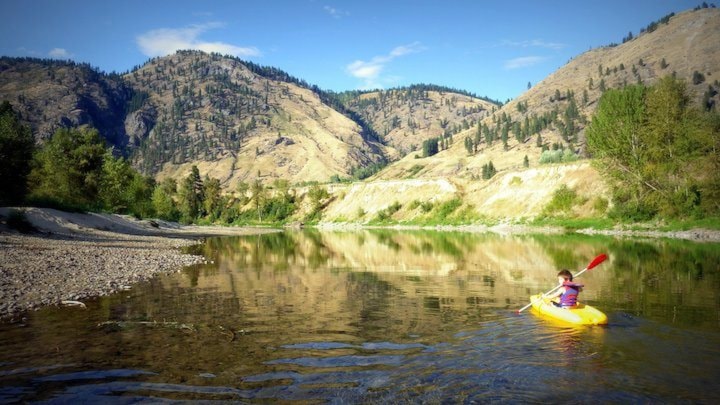Ninety-ninth in a series on West Kootenay/Boundary place names
The Kettle River was named by July 31, 1860 when the Victoria Daily British Colonist quoted a New Westminster Times report about gold being found “on all the tributaries of the Okinakin [sic] Rock Creek, Kettle River, and Semilkameen [sic] in paying quantities.”
There are a couple of theories about the name’s origin. As G.P.V. and Helen Akrigg put it in British Columbia Place Names, one possibility is that it “comes from the boiling, seething Kettle Falls, which were known as La Chaudiére [The Boiler] to early explorers.”
Alternatively, it comes from “the round holes, shaped like cauldrons, which water has hollowed out in the rocks.” Hudson’s Bay Co. governor George Simpson gave the latter explanation in 1847, according to the Akriggs, although they didn’t say where.
The river, and its valley, was previously known by the Okanagan name Nehoialpitku, according to Lt. Charles Wilson of the British Boundary Commission, who wrote on Aug. 31, 1860: “We started for to continue our journey to Colville and passing throughout he town of Rock Creek followed down the stream of the Nehoialpitku. Oh! Valley of the Nehoialpitku, how shall I sing thy praises!”
(The name is otherwise written as nxʷyaʔłpítkʷ. Colonial secretary Arthur Birch gave it as N-whoy-alpit-kwu in a letter written on Oct. 31, 1864.)
When a post office application was filed in 1891 near what was then called Grande Prairie (and is now called Grand Forks), postal inspector E.H. Fletcher wrote: “As there is already a post office in operation [known] as Grande Prairie it would not be desirable to duplicate the name, and the establishment of the office applied for as ‘Kettle River’ will be satisfactory.”
He was wrong. Three years after the Kettle River post office opened in 1892, residents petitioned for a name change, feeling Kettle River was too general, since there were many settlements along it. So it was renamed Carson in 1896 and operated until 1915.
The north fork of the Kettle River became known as the Granby after the Granby Consolidated Mining and Smelting Co. of Granby, Que. which built a smelter at Grand Forks in 1900. The name was officially adopted by the Geographic Board of Canada on March 31, 1915.
The name Kettle Valley, meanwhile, dates to the creation of the Kettle Valley Railway Co. in early 1898. Kettle Valley, the community just east of Rock Creek, dates to before 1913, when the post office opened. It closed in 1975.
What’s strange at first glance, however, is that instead of taking its name from the Kettle, the district came to be known for a tributary, Boundary Creek. We’ll look at this in greater detail next week.
Previous installments in this series
Applegrove, Appleby, and Appledale revisited
Bakers, Birds, and Bosun Landing
Bannock City, Basin City, and Bear Lake City
Bealby Point (aka Florence Park) revisited
Boswell, Bosworth, Boulder Mill, and Broadwater
Brooklyn, Brouse, and Burnt Flat
Camborne, Cariboo City, and Carrolls Landing
Carmi, Cedar Point, Circle City, and Clark’s Camp
Carson, Carstens, and Cascade City
Christina City and Christian Valley
Cody and Champion Creek revisited
Champion Creek revisited, again
Columbia City, Columbia Gardens, and Columbia Park
Crawford Bay and Comaplix revisited
Dawson, Deadwood, and Deanshaven
English Cove and English Point
Forslund, Fosthall, and Fairview
Fort Shepherd vs. Fort Sheppard, Part 1
Fort Shepherd vs. Fort Sheppard, Part 2
Gladstone and Gerrard, revisited
Granite Siding and Granite City
Hall Siding and Healy’s Landing
Hudu Valley, Huntingtdon, and Healy’s Landing revisited
Inonoaklin Valley (aka Fire Valley)
